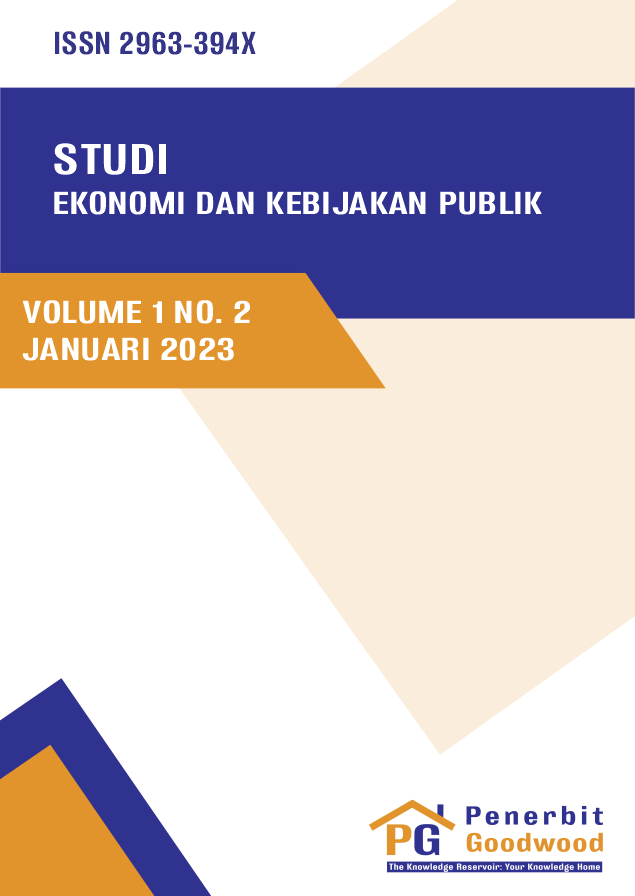SINTA 6 | Studi Ekonomi dan Kebijakan Publik adalah jurnal ilmiah yang mempublikasikan artikel ilmiah yang mengangkat topik ekonomi dan kebijakan publik serta topik-topik terkait. Naskah yang dikirimkan ke Studi Ekonomi dan Kebijakan Publik akan direview dengan metode double-blind peer review oleh mitra bestari pilihan kami. Studi Ekonomi dan Kebijakan Publik bertujuan untuk menjawab berbagai isu serta memediasi penyebarluasan perkembangan teoritis dan praktis di bidang ekonomi dan kebijakan publik melalui publikasi ilmiah.
Published
2023-01-03
Purpose: The purpose of this study is to see whether there are direct and indirect effects of inflation to interest rates, and also to see the direct and indirect relationship between inflation and interest rates to the IHSG using path analysis for the period January 2016 to July 2022.
Research Methodology: To answer the research objectives, a path analysis model was used. This study uses time series data during January 2016 to July 2022
Result: The results of the study This study finds that there is a direct effect between inflation and interest rates. However, this study did not find a direct effect of inflation on the IHSG. In this study, joint testing found that interest rates and inflation had a direct effect on the IHSG.
Purpose: This community service aims to develop the salak fruit business through the entrepreneur school program by collaborating with students to increase the selling value of the salak fruit so as to reduce the poverty rate.
Methodology: The implementation of this community service uses the method of providing motivation and training in developing salak fruit products in farmer groups in Wonoharjo Village, which is carried out directly and data collection through questionnaires.
Results: The results of community service show that providing motivation and training for farmer groups in Wonoharjo Village, both those who already have businesses and those who are able to provide business management knowledge and develop salak fruit businesses by utilizing the potential of existing land by working with students, so that salak fruit products can be of high selling value.
Conclusion: The synergy framework between salak fruit farmers and academics, consisting of people who have active salak fruit plantations in Dea Wonoharjo, is important because salak fruit farmers will be more optimal in developing their business both offline and online. The program carried out with students has a positive impact as a solution to the problems of salak fruit farmers during the pandemic. Thus, the selling value of salak can be of high selling value. In addition, it is also expected to reduce the level of poverty.
Purpose: This study aims to determine the characteristics of previous studies on economic recovery
Research Methodology: This research is a bibliometric study using the charting the field method developed by Hesford et al., (2006).
Results: 46 articles from 2021-2022 were obtained from the Sinta accredited journal with the keyword economic recovery. The majority articles are from 2021, Sinta 5, economic journal, used qualitative research, secondary data sources. Last, three strategies most discussed were empowerment of MSMEs, the provision of social assistance, and the use of Islamic financial instruments.
Limitations: This study uses only two of the three classifications developed by Hesford et al (2006).
Contribution: The novelty in this research is to propose a new classification based on the focus and scope of journals, Sinta's accreditation rating, types of research, types of data sources, data collection methods, and economic recovery strategies discussed.
Purpose: The study is to determine the impact of debt policy on the IDX listed pharma dividend policy, liquidity impact on the IDX listed pharma dividend policy, and profitability impact on the IDX listed pharma dividend policy. The impact of debt policy, liquidity and profitability on the dividend policy of pharmaceutical companies concurrently or partially listed on the IDX.
Methodology: This study uses quantitative methods and secondary data. The scope of this research relates to data on manufacturing companies listed on the Indonesia Stock Exchange in 2017 - 2020.
Results: Results: The results of multiple linear regression analysis show that debt, liquidity, and profitability policies have an effect on dividend policy on the Indonesia Stock Exchange. On the other hand, some profitability has a negative effect on dividend policy. However, debt and liquidity policies have a partial positive effect on dividend policy. Limitations: Only tested 3 factor variables that affect dividen policy in a certain period.
Contribution: It is hoped that this research can be useful for investors who will invest in certain pharmaceutical business sectors to be more careful in paying attention to various factors that affect stock returns.
Purpose: This study aims to analyze and prove the effect of population, per capita income, and foreign investment on the open unemployment rate in Indonesia, including population, per capita income, and foreign investment.
Methodology: The method used in this research is multiple linear regression analysis with the least squares or ordinary least square calculation model, namely by minimizing the sum of the squares of the regression error or error.
Results: The results of this study are that the number of people has a statistically significant positive effect; GDP Per Capita has a statistically significant negative effect; and foreign investment has a statistically significant negative effect on the Open Unemployment Rate.
Conclusion: All independent variables have a significant effect on the open unemployment rate in Indonesia.


 Google Scholar
Google Scholar Garuda
Garuda Sinta
Sinta
